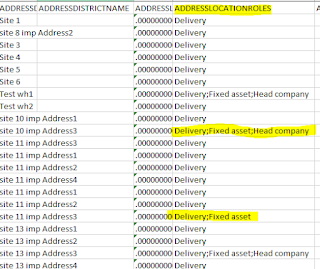Data entity methods in d365fo.
// This method is hitting while updating and inserting
// we can assign datasource1 recid values to child data source.
//
public void mapEntityToDataSource(DataEntityRuntimeContext _entityCtx,
DataEntityDataSourceRuntimeContext _dataSourceCtx)
{
if (_entityCtx.getDatabaseOperation() == DataEntityDatabaseOperation::Insert
|| _entityCtx.getDatabaseOperation() == DataEntityDatabaseOperation::Update)
{
if (_dataSourceCtx.name() == dataEntityDataSourceStr(MyEntity, MyDataSource))
{
TestCustomer testCustomer = _entityCtx.getRuntimeContextByName(
dataEntityDataSourceStr(MyEntity,
TestCustomer)).getBuffer();
this.CustomerRecid = testCustomer.recid;
}
}
super(_entityCtx, _dataSourceCtx);
}
-------------------------------------------------------------------------------------------------------------
// After inserting into staging this method will trigger
// Ref: LedgerJournalEntity
public static void postGetStagingData(DMFDefinitionGroupExecution
_dmfDefinitionGroupExecution)
{
MyStaging staging;
ttsbegin;
while select forupdate staging
where staging.DefinitionGroup == _dmfDefinitionGroupExecution.DefinitionGroup
&& staging.ExecutionId == _dmfDefinitionGroupExecution.ExecutionId
&& staging.TransferStatus == DMFTransferStatus::NotStarted
{
staging.Field1 = staging.Field2 + '-' + staging.Field3;
staging.Field4 = staging.Field5;
staging.update();
}
/*update_recordset staging
setting OperationalEntityId = curExt()
where staging.DefinitionGroup == _dmfDefinitionGroupExecution.DefinitionGroup
&& staging.ExecutionId == _dmfDefinitionGroupExecution.ExecutionId
&& staging.TransferStatus == DMFTransferStatus::NotStarted;*/
ttscommit;
}
-------------------------------------------------------------------------------------------------------------
// Executes the logic once after processing the target data.
public static void postTargetProcess(DMFDefinitionGroupExecution _dmfDefinitionGroupExecution)
{
if (_dmfDefinitionGroupExecution.StagingStatus == DMFBatchJobStatus::Finished)
{
MyStaging staging;
ttsbegin;
while select forupdate staging
where staging.DefinitionGroup == _dmfDefinitionGroupExecution.DefinitionGroup
&& staging.ExecutionId == _dmfDefinitionGroupExecution.ExecutionId
&& staging.TransferStatus == DMFTransferStatus::Completed
{
staging.Field1 = staging.Field2 + '-' + staging.Field3;
staging.Field4 = staging.Field5;
staging.update();
}
/*update_recordset staging
setting OperationalEntityId = curExt()
where staging.DefinitionGroup == _dmfDefinitionGroupExecution.DefinitionGroup
&& staging.ExecutionId == _dmfDefinitionGroupExecution.ExecutionId
&& staging.TransferStatus == DMFTransferStatus::Completed;*/
ttscommit;
}
---------------------------------------------------------------------------------
// Validate the each line.
// LedgerJournalEntity
public boolean validateWrite()
{
boolean isValid = super();
// Your logic
return isValid;
}
-------------------------------------------------------------------------------------------------------------
// Validate the each line.
// LedgerJournalEntity
public boolean validateDelete()
{
boolean isValid = super();
// Your logic
return isValid;
}
-------------------------------------------------------------------------------------------------------------
//Skip validate field code written in this method
//Reference : LogisticsPostalAddressElectronicContactV2Entity
public void persistEntity(DataEntityRuntimeContext _entityCtx)
{
_entityCtx.getEntityRecord().skipDataSourceValidateField(
fieldNum(ElectronicContactsEntity, Location), true);
super(_entityCtx);
}
-------------------------------------------------------------------------------------------------------------
// Assign default values
// WE can assign number sequence also.
// SMMContactPersonV2Entity
public void initValue()
{
if (!this.skipNumberSequenceCheck())
{
NumberSeqRecordFieldHandler::enableNumberSequenceControlForField(
this, fieldNum(PIDInvestigatorContactPersonEntity, ContactPersonId),
ContactPerson::numRefContactPersonId());
}
this.ContactForParty = Parameters::find().ContactForParty;
super();
}
-------------------------------------------------------------------------------------------------------------
- initializeEntityDataSource
// Assign values to some fields based on some field values.
//Reference : LogisticsPostalAddressElectronicContactV2Entity
public void initializeEntityDataSource(DataEntityRuntimeContext _entityCtx,
DataEntityDataSourceRuntimeContext _dataSourceCtx)
{
if (_dataSourceCtx.name() == dataEntityDataSourceStr(MyEntity, MyDataSource))
{
ContactPerson contactPerson = ContactPerson::find(this.contactPersonId);
if (this.LocationId == '')
{
DirPartyLocation dirPartyLocation = DirPartyLocation::findOrCreate(
contactPerson.party, false);
LogisticsLocation logisticsLocation = LogisticsLocation::find(
dirPartyLocation.Location);
this.LocationId = logisticsLocation.LocationId;
this.Location = logisticsLocation.RecId;
this.Party = contactPerson.party;
_dataSourceCtx.setBuffer(logisticsLocation);//set buffer
}
}
if (_dataSourceCtx.name() == dataEntityDataSourceStr(MyEntity, MyDataSource1))
{
DirPartyLocation dirPartyLocationNew =
DirPartyLocation::findByPartyLocation(this.Party, this.Location);
_dataSourceCtx.setBuffer(dirPartyLocationNew);
}
super(_entityCtx, _dataSourceCtx);
}
-------------------------------------------------------------------------------------------------------------
// While inserting into target
//Reference :InventOperationalSiteV2Entity
public boolean insertEntityDataSource(DataEntityRuntimeContext _entityCtx,
DataEntityDataSourceRuntimeContext _dataSourceCtx)
{
boolean ret;
if (_dataSourceCtx.name() ==
dataEntityDataSourceStr(InventOperationalSiteV2Entity, ReqSitePolicy))
{
_dataSourceCtx.setDatabaseOperation(DataEntityDatabaseOperation::Insert);
}
ret = super(_entityCtx, _dataSourceCtx);
return ret;
}
-------------------------------------------------------------------------------------------------------------
// While updating into target
//Reference :InventOperationalSiteV2Entity
public boolean updateEntityDataSource(DataEntityRuntimeContext _entityCtx,
DataEntityDataSourceRuntimeContext _dataSourceCtx)
{
boolean ret;
ret = super(_entityCtx, _dataSourceCtx);
return ret;
}
Keep Daxing!!



